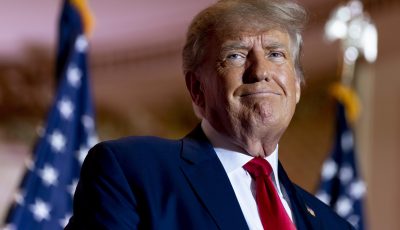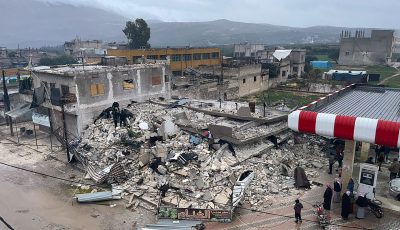The Gettysburg Address 2.0: Donald Trump’s first 100 days in office
1. The Gettysburg Address 1.0
In the early morning of Nov. 9, 2016, Donald Trump became President-elect. His stunning series of victories in the Great Lakes states irremediably cracked the Democratic “Blue Wall” (Wisconsin, Indiana, Michigan, Ohio and Pennsylvania). The first question after this was: What next?
“Four score and seven years” after the U.S. declaration of independence on July 4, 1776, more precisely on Nov. 19, 1863, Abraham Lincoln was delivering his famous address (“Dedicatory Remarks”) at the Soldiers’ National Cemetery in Gettysburg, Pennsylvania, four and a half months after the Union armies defeated the armies of the Confederacy at the Battle of Gettysburg. In just about two minutes, Lincoln delivered one of the most influential statements of national importance, in an effort to unify a deeply divided nation, in the midst of its first civil war. In the speech, the president redefined the war not just as a struggle for the Union, but also for the principle of human equality. He praised the sacrifices of the fallen on the battlefield, and acclaimed the virtues of the living. These would ensure “a new birth of freedom” for the nation, in order for a “government of the people, by the people, for the people” to “not perish from the earth.”
“Four score and seven” days after the Democratic National Convention in Philadelphia ended on July 28, 2016, more precisely on Oct. 22, 2016, the then-Republican presidential candidate, Donald Trump, was delivering his Gettysburg address, also in an effort to unify a divided nation and make America great again. While at Gettysburg, Trump chose to stop at the site of Pickett’s Charge, where 12,000 Confederate soldiers attacked Union lines unsuccessfully. The place has been referred to as “the high-water mark of the Confederacy.”
The Union victories at Gettysburg (Pennsylvania) and Vicksburg (Mississippi), on July 3 and 4, 1863, split the Confederacy in two, and these two battles are considered the turning point of the Civil War.
Trump’s decision to stop at Pickett’s Charge was not coincidental. Pickett’s Charge became an iconic symbol of the cultural and literary movement known as the Lost Cause of the Confederacy. The Lost Cause is a set of beliefs that endorse the virtues of the antebellum South, viewing the civil war as an honorable struggle for the White American Southern way of life.
Consequently, Trump has channeled the energy of his supporters, who firmly believe they fight a noble cause, and fear they would be defeated because of the “rigged system” and “unfair” mainstream media. Having said that, I think it is fair to consider that the Republican Party of today captures the reborn values of the Confederacy, and Lincoln’s party reflects now, to a great extent, the values of Jefferson Davis and Donald Trump.
Inspired by Lincoln’s address, Trump stated that “it is my privilege to be here in Gettysburg, hallowed ground where so many lives were given in service to freedom—amazing place,” that “President Lincoln served in a time of division like we’ve never seen before,” and that “it is my hope that we can look at his example to heal the divisions we are living through right now. We are a very divided nation.” He also said: “This is a struggle for the survival of our nation. This election will determine whether we are a free nation, or whether we have only the illusion of democracy, but are, in fact, controlled by a small handful of global special interests rigging the system. This is not just conspiracy, but reality, and you and I know it.”
2. The Gettysburg Address 2.0
2.1. The Contract with the American voter
At Gettysburg, Trump decided to deliver his Contract with the American Voter, a 100-day action plan to Make America Great Again.
His plan is divided into four parts, each of them containing a set of “measures” and “actions.” In order for its essence to be easier retained and understood, I would describe the “action plan” as a 28-article “contract” between Trump and the American voter, consisting in a “6 (measures)—7 (actions)—5 (actions)—10 (measures)” set about: cleaning up the anti-corruption and special interest in Washington, D.C.; protecting the American workers; restoring security and the constitutional rule of law; and introducing, and fighting for the passage of, broader legislative measures in the U.S. Congress.
2.2. Anti-corruption
The “anti-corruption and special interest” package contains the following six measures:
(1) propose a constitutional amendment to impose term limits on all members of Congress;
(2) a hiring freeze on all federal employees to reduce federal workforce through attrition (exempting military, public safety, and public health);
(3) a requirement that for every new federal regulation, two existing regulations must be eliminated;
(4) a five-year ban on White House and congressional officials becoming lobbyists after they leave government service;
(5) a lifetime ban on White House officials lobbying on behalf of a foreign government;
(6) a complete ban on foreign lobbyists raising money for American elections.
2.3. Workers protection
The “American workers protection” package contains the following seven actions:
(1) announcing the intention to renegotiate NAFTA or withdraw from the deal under Article 2205;
(2) announcing the withdrawal from the Trans-Pacific Partnership;
(3) directing the Secretary of Treasury to label China a currency manipulator;
(4) directing the Secretary of Commerce and U.S. trade representative to identify all foreign trading abuses that unfairly impact American workers and directing them to use every tool under American and international law to end those abuses immediately;
(5) lifting the restrictions on the production of $50 trillion worth of job-producing American energy reserves, including shale, oil, natural gas and clean coal;
(6) lifting the Obama-Clinton roadblocks and allowing vital energy infrastructure projects, like the Keystone pipeline, to move forward;
(7) cancel billions in payments to U.N. climate change programs and using the money to fix America’s water and environmental infrastructure.
To be continued tomorrow.
***
Tiberiu Dianu has published several books and over 100 articles in law, politics, and post-communist societies. He currently lives and works in Washington, D.C.



























